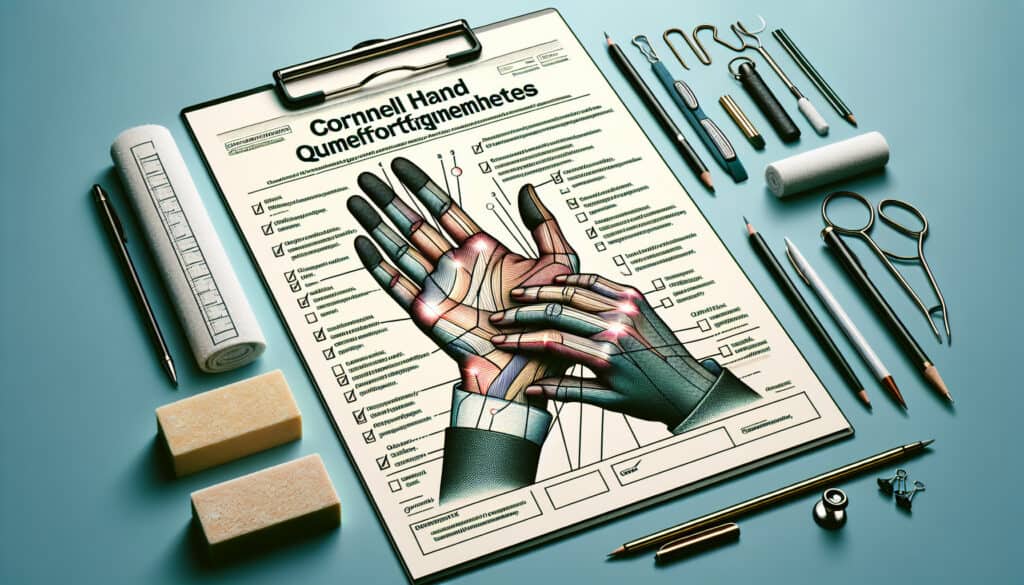A set of questionnaires used to assess the severity, frequency, and location of musculoskeletal discomfort in the hands, wrists, and forearms.
- Metodologie: Lean Sigma, Produzione
Cornell Hand Discomfort Questionnaires

Cornell Hand Discomfort Questionnaires
- Ergonomia, Scienze della salute, Fattori umani, Ingegneria dei fattori umani (HFE), Miglioramento dei processi, Controllo di qualità, Gestione della qualità, Gestione del rischio, Sicurezza
Obiettivo:
Come si usa:
- These are self-administered surveys where individuals rate their level of discomfort in different body parts on a diagram. They are used in ergonomic surveillance to identify individuals or tasks that may pose a risk for injury.
Professionisti
- Simple and quick for users to complete, provides a standardized way to collect subjective discomfort data, and helps in the early identification of potential musculoskeletal issues.
Contro
- Data is subjective and relies on self-reporting, may not directly identify the cause of the discomfort, and should be used as part of a broader ergonomic assessment, not in isolation.
Categorie:
- Ergonomia, Risorse umane, Gestione del rischio
Ideale per:
- Screening for and tracking the prevalence of upper limb discomfort in a workforce to prioritize ergonomic interventions.
The Cornell Hand Discomfort Questionnaire (CHDQ) is a valuable tool for assessing discomfort in the upper limbs, particularly in environments where repetitive motions or awkward postures are prevalent, such as manufacturing, assembly lines, and office settings. This survey can be particularly useful during the evaluation phase of workplace design or when implementing new ergonomic strategies, allowing designers and engineers to amend processes or workstations based on quantified feedback from employees. Key participants in this assessment include ergonomists, occupational health specialists, safety managers, and employees themselves, ensuring a comprehensive perspective on discomfort levels. The CHDQ not only serves as a screening tool but also aids in longitudinal studies to track changes in discomfort over time, facilitating proactive adjustments to workplace ergonomics and supporting injury prevention strategies. Typical applications also include integration into health and safety programs within various industries, such as healthcare and warehousing, where it becomes part of regular health assessments. The simplicity and speed of the questionnaire attract more individuals to participate, ensuring that data collected is reflective of the actual conditions experienced by workers. With regular data collection and review, organizations can prioritize which interventions would yield the greatest impact on worker wellbeing and productivity, ultimately leading to a reduction in work-related musculoskeletal disorders and associated absenteeism.
Fasi chiave di questa metodologia
- Select the body parts to be assessed on the provided diagram.
- Rate the level of discomfort for each selected body part using the defined scale.
- Note any specific tasks associated with reported discomfort.
- Document the frequency and duration of discomfort episodes.
- Identify any potential risk factors or ergonomic issues related to tasks performed.
Suggerimenti per i professionisti
- Incorporate a psychometric assessment to validate the questionnaire’s effectiveness in measuring discomfort, ensuring that responses accurately reflect the workers' experiences.
- Utilize longitudinal data collection to track discomfort trends over time, correlating findings with specific interventions to assess their impact on reducing musculoskeletal issues.
- Complement the questionnaire with qualitative interviews or focus groups for deeper context around reported discomfort, allowing for more targeted ergonomic solutions.
Leggere e confrontare diverse metodologie, raccomandiamo il
> Ampio archivio di metodologie <
insieme ad altre 400 metodologie.
I vostri commenti su questa metodologia o ulteriori informazioni sono benvenuti su sezione commenti qui sotto ↓ , così come tutte le idee o i link relativi all'ingegneria.
Contesto storico
1986
(se la data non è nota o non è rilevante, ad esempio "meccanica dei fluidi", viene fornita una stima approssimativa della sua notevole comparsa)

Post correlati
Gestione delle operazioni di produzione (MOM)
Sistema di esecuzione della produzione (MES)
Piano di controllo della produzione
Test manuali
Schede di valutazione della movimentazione manuale (MAC)
ManTRA (Strumento di valutazione dei rischi delle attività manuali)